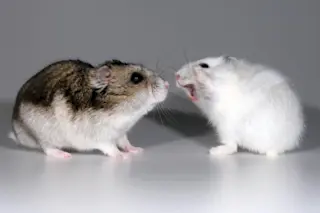A female hamster (right) is not happy, and makes it known. (Credit: Frank Scherbarth)
What makes female Siberian hamsters ready to duke it out in the winter? Melatonin.
The same hormone gaining popularity as a natural sleep aid plays a major role in seasonal aggression in female hamsters, according to new research. The study, published this week in the Proceedings of the Royal Academy B, is a collaboration between the Indiana University Bloomington College of Arts and Sciences’ departments of Biology and Psychological and Brain Sciences.
And just as a reminder: Winter is coming.
Lead author Nikki Rendon, a Ph.D. student in biology, said biology professor Gregory Demas had previously published research on seasonal changes in aggression in male hamsters, and she wanted to see what was going on with females. She and the team, which included Demas, expected to find a link between aggression and sex hormones, but what ...














